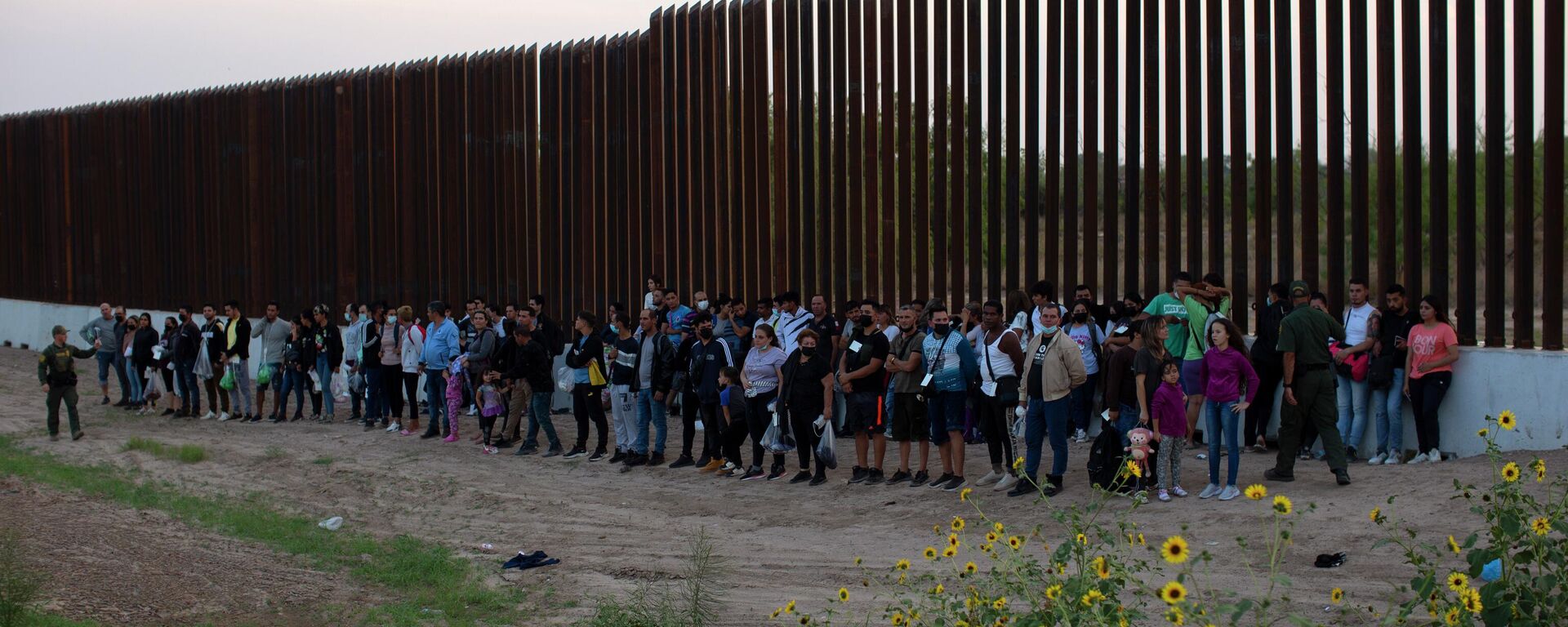https://sputnikglobe.com/20221228/face-of-us-changing-as-migration-becomes-major-driver-of-population-growth-1105859788.html
Face of US Changing as Migration Becomes Major Driver of Population Growth
Face of US Changing as Migration Becomes Major Driver of Population Growth
Sputnik International
As growth in the US population is showing early indicators of recovery after the COVID pandemic, net migration has emerged as the largest driver behind the... 28.12.2022, Sputnik International
2022-12-28T16:00+0000
2022-12-28T16:00+0000
2022-12-28T16:00+0000
americas
us
opinion
us census
population growth
migration
demographics
border
texas
florida
https://cdn1.img.sputnikglobe.com/img/07e5/03/11/1082374857_0:160:3073:1888_1920x0_80_0_0_70dc522b0a087dc69505df31f6f84547.jpg
Considerably low growth rates in the US between 2020 and 2021 were followed by an uptick: the US resident population increased by 1,256,003, to 333,287,557 in 2022, according to the US Census Bureau’s Vintage 2022 data.Net international migration (the number of people moving in and out of the country) was the primary driver of growth, adding a whopping 1,010,923 people between 2021 and 2022. For comparison's sake, the "positive natural change" – births minus deaths – increased the US population by 245,080. Remarkably, the year-over-year increase in total births was the largest since 2007, as Kristie Wilder, a demographer in the Population Division at the Census Bureau, said in an official statement.The data indicated that the South was the largest-gaining region last year, increasing by 1.1%, or 1,370,163. The major components responsible for the growth were positive net domestic migration (867,935) and net international migration (414,740), according to the bureau.The second largest-growing region was the West, which gained 153,601 residents which brought a total resident population of 78,743,364. The region saw gains even despite losing 233,150 residents via net domestic migration.At the same time, the Northeast and the Midwest lost 218,851 and 48,910 residents, respectively, due to negative net domestic migration.Texas and Florida were singled out by the Census Bureau as the largest-gaining states between 2021 and 2022. The Lone Star State saw an increase due to: first, net domestic migration (230,961); second, net international migration (118,614); and, third, natural increase (118,159). As a result, this past year Texas crossed the threshold of 30 million people.For its part, Florida saw an increase of 416,754 residents, with net migration being the largest contributing component of change. Of this number, net international migration added 125,629 people and net domestic migration added 318,855. However, at the same time, the Sunshine State had the highest natural decrease at -40,216.The changes in annual growth came at a time of the simmering southern border crisis under the Biden administration. According to Customs and Border Protection data, the number of total encounters with illegals at the border during the fiscal year 2022 reached a staggering 2,378,944, while in 2021 it was 1,734,686. For comparison's sake, under then-President Donald Trump it was 458,088 in 2020; and 977,509 in 2019.The spike in the flow of undocumented migrants to southern US states prompted fierce criticism of Joe Biden's border policies by the GOP-led Texas, Florida, and Arizona governments.On Monday, the White House complained that Texas Governor Greg Abbott had dropped a busload of migrants at Vice President Kamala Harris' doorstep on Christmas Eve. Prior to that, Abbott wrote a letter to the US president urging him to "stop the lie that the [US southern border] is secure and instead immediately deploy federal assets to address the dire problems you have caused."For his part, Florida Governor Ron DeSantis flew undocumented migrants to Democratic strongholds in response to the White House's unwillingness to take the problem seriously. Arizona Governor Doug Ducey earlier stated that he would continue busing migrants from his state to Washington, DC, until he leaves office on January 2, 2023.The influx of international migrants – both legal and illegal – which considerably outpaces the natural change in the US is set to change the face of America in the coming decades. Thus, according to the US Census Bureau's earlier projections, a majority of the US population will be non-white by the year 2050. Demographers suggest that the white share of the US population has been dropping since 1950 and will continue to go down in the future. For their part, Hispanics, African Americans, and Asian Americans will emerge as the nation's main demographic engine.In 2019, a Pew Research poll concerning future demographic changes in the US found that just a third of American adults said that this change would be either very (17%) or somewhat (18%) good; roughly a quarter said it would be very (15%) or somewhat (8%) bad; and 42% say the change would be neither good nor bad. At the same time, however, about half of Americans said that this shift could lead to more conflicts between racial and ethnic groups. About four-in-ten suggested that a majority non-white population could "weaken American customs and values."
https://sputnikglobe.com/20221115/texas-governor-invokes-invasion-clauses-to-stem-influx-of-illegal-migration-1104261986.html
https://sputnikglobe.com/20221226/why-do-gop-run-states-bus-migrants-to-democratic-run-ones-1105798977.html
americas
texas
florida
arizona
Sputnik International
feedback@sputniknews.com
+74956456601
MIA „Rossiya Segodnya“
2022
News
en_EN
Sputnik International
feedback@sputniknews.com
+74956456601
MIA „Rossiya Segodnya“
Sputnik International
feedback@sputniknews.com
+74956456601
MIA „Rossiya Segodnya“
what's the main driver of us population growth, net migration, illegal migrant influx, white population in us is in decline, us population by race, what percentage of the us population is non-white, hispanic population, african americans, asian americans
what's the main driver of us population growth, net migration, illegal migrant influx, white population in us is in decline, us population by race, what percentage of the us population is non-white, hispanic population, african americans, asian americans
Face of US Changing as Migration Becomes Major Driver of Population Growth
As growth in the US population is showing early indicators of recovery after the COVID pandemic, net migration has emerged as the largest driver behind the trend, according to the US Census Bureau.
Considerably low growth rates in the US between 2020 and 2021 were followed by an uptick: the US resident population increased by 1,256,003, to 333,287,557 in 2022,
according to the US Census Bureau’s Vintage 2022 data.
Net international migration (the number of people moving in and out of the country) was the primary driver of growth, adding a whopping 1,010,923 people between 2021 and 2022. For comparison's sake, the "positive natural change" – births minus deaths – increased the US population by 245,080. Remarkably, the year-over-year increase in total births was the largest since 2007, as Kristie Wilder, a demographer in the Population Division at the Census Bureau, said in an official statement.
The data indicated that the South was the largest-gaining region last year, increasing by 1.1%, or 1,370,163. The major components responsible for the growth were positive net domestic migration (867,935) and net international migration (414,740), according to the bureau.
The second largest-growing region was the West, which gained 153,601 residents which brought a total resident population of 78,743,364. The region saw gains even despite losing 233,150 residents via net domestic migration.
At the same time, the Northeast and the Midwest lost 218,851 and 48,910 residents, respectively, due to negative net domestic migration.

15 November 2022, 18:00 GMT
Texas and Florida were singled out by the Census Bureau as the largest-gaining states between 2021 and 2022. The Lone Star State saw an increase due to: first, net domestic migration (230,961); second, net international migration (118,614); and, third, natural increase (118,159). As a result, this past year Texas crossed the threshold of 30 million people.
For its part, Florida saw an increase of 416,754 residents, with net migration being the largest contributing component of change. Of this number, net international migration added 125,629 people and net domestic migration added 318,855. However, at the same time, the Sunshine State had the highest natural decrease at -40,216.
The changes in annual growth came at a time of
the simmering southern border crisis under the Biden administration. According to Customs and Border Protection data, the number of total encounters with illegals at the border during the fiscal year 2022 reached a staggering 2,378,944, while in 2021 it was 1,734,686. For comparison's sake, under then-President Donald Trump it was 458,088 in 2020; and 977,509 in 2019.

26 December 2022, 14:25 GMT
The spike in the flow of undocumented migrants to southern US states prompted fierce criticism of Joe Biden's border policies by the GOP-led Texas, Florida, and Arizona governments.
On Monday, the White House complained that Texas Governor Greg Abbott had dropped a busload of migrants
at Vice President Kamala Harris' doorstep on Christmas Eve.
Prior to that, Abbott wrote a letter to the US president urging him to "stop the lie that the [US southern border] is secure and instead immediately deploy federal assets to address the dire problems you have caused."For his part, Florida Governor Ron DeSantis flew undocumented migrants to Democratic strongholds in response to the White House's unwillingness to take the problem seriously. Arizona Governor Doug Ducey earlier stated that he would continue busing migrants from his state to Washington, DC, until he leaves office on January 2, 2023.
The influx of international migrants – both legal and illegal – which considerably outpaces the natural change in the US is set to change the face of America in the coming decades. Thus, according to the US Census Bureau's earlier projections, a majority of the US population will be non-white by the year 2050. Demographers suggest that the white share of the US population has been dropping since 1950 and will continue to go down in the future. For their part, Hispanics, African Americans, and Asian Americans will emerge as the nation's main demographic engine.
In 2019, a Pew Research poll concerning future demographic changes in the US
found that just a third of American adults said that this change would be either very (17%) or somewhat (18%) good; roughly a quarter said it would be very (15%) or somewhat (8%) bad; and 42% say the change would be neither good nor bad. At the same time, however, about half of Americans said that this shift could lead to more conflicts between racial and ethnic groups. About four-in-ten suggested that a majority non-white population could "weaken American customs and values."




